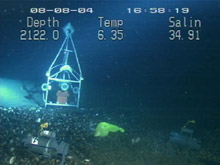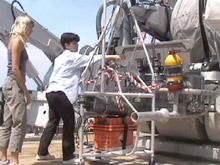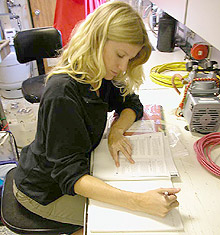
The Eye-in-the-Sea deployed on the edge of the brine pool, over 2,100 ft deep in the Gulf of Mexico. Click image for larger view and further details.
Eye-in-the-Sea Explores the Brine Pool
August 8, 2004
Erika HeineGraduate Student
Johns Hopkins University/Harbor Branch Oceanographic Institute
Dr. Sönke Johnson once told me, “Never throw anything into the ocean that you want to see again.” This thought ran through my mind today as I prepared the Eye-in-the-Sea (EITS) camera system for deployment to the sea floor, 2,000 ft down. The EITS will help us observe marine animals in their natural habitat without disturbing them. This one-of-a-kind system was originally developed by my advisor, Dr. Edie Widder, and has recently been placed in my care.
Like any unique instrument, EITS demands a well thought out deployment strategy, the meticulous execution of several pre-dive steps, and good karma.![]() Click here to understand more about the steps involved in deploying EITS.
Click here to understand more about the steps involved in deploying EITS.

Dr. Edie Widder inspects the Eye-in-the-Sea one last time before deployment. It will sit on the bottom for 24 hours before being retrieved. Click image for larger view.
Today, for the first time ever, we deployed EITS on the edge of a unique deep-sea habitat, the Brine Pool. The Brine Pool was formed as a result of plate tectonics and, later, the seepage of dense saltwater through the less dense sediment overlying it. Never before has an unobtrusive camera system been left at the edge of one of these pools. We are excited and anxious to see what lives in this bizarre underwater environment and find out a little about what they "say" to each other.
As we descended onto the lunar-like landscape of the sea floor, I noticed a white substance blanketing otherwise barren mounds of earth. (Could the talcum powder we’ve been using to mask the “ahrrr matey” smell of our shoes have drifted down to the bottom?) Edie quickly pointed out that the white material was mats of chemosynthetic bacteria. We collected some of the mats for analysis at the surface. The submersible continued along the bottom, moving over a thick bed of mussels. Feeding off of the methane that seeps from the ground below them, these mussels are prolific along the brine pool's perimeter. What we are looking for, however, are animals more likely to "talk back to us" when we flash lights like theirs back at them. We are in search of animals that are bioluminescent (light creating).
Suddenly, the mussel bed ended and the inky "shoreline" of dense seawater began. We were at the Brine Pool. It was an impossible sight: an underwater lake. Tim, our sub pilot, spotted a flat zone on the northeast side of the lake that was suitable for EITS. The lake is so dense and impenetrable that Tim "landed" the submersible on the lake's surface while off-loading EITS.
Positioned to view an artificial jellyfish and bait bag, EITS was left "peering" out across the lake. Several hagfish, eager to investigate our bait bag, slithered along the ledge of the Brine Pool. I wondered what strange organisms might emerge from the lake. Pressed for time, we deployed Dr. Tammy Frank’s crab traps near EITS and headed for the surface.
Tonight, while the gentle rolling of the ocean rocks me back and forth in my bunk, my mind will not be lulled to sleep by visions of sheep leaping over barnyard fences. Rather, I will be counting the fathoms of luminescent water between our ship and EITS, quietly capturing the story of creatures from below.
























